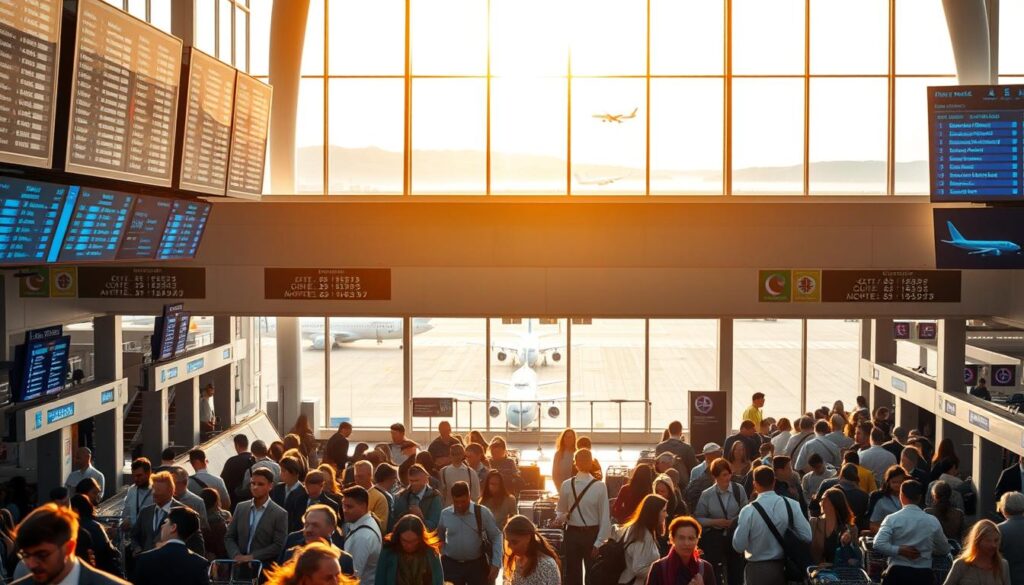Travel Seasons Explained: Peak, Shoulder, and Off-Peak Travel
As budget-conscious travelers, we’re always on the lookout for ways to maximize the value of our trips. Understanding travel seasons is crucial for planning a successful journey. The concept of travel seasons categorizes the year into periods based on demand for travel services.
There are three main categories: peak travel, when destinations are most crowded and prices are highest; shoulder travel, which offers a balance between decent weather and lower prices; and off-peak travel, characterized by fewer tourists and often significantly reduced costs.
Knowing when to travel can make a significant difference in your experience, from avoiding crowds to saving money. Whether you’re a frequent flyer or an occasional traveler, understanding these travel seasons can enhance your travel planning.
Understanding Travel Seasons
To make informed travel decisions, it’s necessary to grasp the concept of peak, shoulder, and off-peak travel seasons. Understanding these seasons can significantly enhance your travel planning experience.
The peak travel season is characterized by high demand, larger crowds, and higher prices. It’s the busiest period, usually during summer or holidays, when most people take their vacations. Peak travel often results in a more vibrant atmosphere, but it can also mean longer queues and higher costs.

In contrast, the shoulder season refers to the period between the peak and off-peak seasons. It’s called the “shoulder” season because it sits on the “shoulders” of the high and low seasons. The shoulder season offers a balance between comfortable weather, fewer crowds, and relatively lower prices, making it an attractive time for travelers who want to avoid the peak season chaos.
The off-peak season, on the other hand, is the least busy period, often resulting in lower prices for accommodations and tourist services. While it may not be the best time for everyone due to potentially unfavorable weather conditions, it’s ideal for travelers on a tight budget or those who prefer fewer tourists.
Understanding these travel seasons is crucial for effective travel planning. By choosing the right season based on your preferences and budget, you can have a more enjoyable and stress-free travel experience.
Travel Seasons Explained: Peak, Shoulder, and Off-Peak Travel
The travel industry is influenced by three main seasons: peak, shoulder, and off-peak, each with its unique characteristics. Understanding these seasons is crucial for travelers to make the most out of their trips.
Characteristics of Peak Season
Peak season transforms destinations into vibrant hubs of activity. High demand for accommodations and tourist services leads to premium pricing, making it a lucrative period for businesses in the travel industry.
During peak season, local shops buzz with energy, and seasonal jobs multiply, contributing to the local economy. Cultural exchanges flourish as tourists from diverse backgrounds interact with the local community.

However, peak season also means large crowds and long waiting lines at popular attractions. Travelers can navigate these challenges by planning ahead, booking services in advance, and considering alternative destinations or activities.
Travel tips for peak season include being flexible with travel dates and taking advantage of early morning or late evening tours to avoid the crowds. Additionally, researching local events and festivals can enhance the travel experience by allowing participation in unique cultural activities.
Understanding the characteristics of peak season and being prepared can help travelers make the most of their trips. By leveraging travel tips and being mindful of the high demand and premium pricing, travelers can enjoy a fulfilling experience even during the busiest travel periods.
In contrast, shoulder and off-peak seasons offer different advantages, such as lower prices and fewer tourists, which can be appealing to those looking for a more relaxed travel experience or budget-friendly options.
Navigating Peak Season Travel
Peak season travel offers a unique experience, but it demands a thoughtful approach to avoid the pitfalls of overcrowding. Strategic planning is essential to make the most of your trip.
To navigate peak season crowds, it’s crucial to plan ahead. Booking accommodations and popular attractions well in advance can save time and reduce stress. Additionally, considering alternative destinations or visiting lesser-known attractions can help distribute the crowds more evenly.

Highlighting local culture is another way to enhance the peak season travel experience. Partnering with local artisans and guides can create unique experiences that take visitors beyond the usual hotspots. This not only benefits the local community but also enriches the traveler’s experience.
Managing Crowds
Effective crowd management is key to enjoying peak season travel. This can involve visiting popular sites early in the morning or later in the evening to avoid the peak tourist hours. Being flexible with your travel dates and considering the shoulder season can also make a significant difference.
By adopting these strategies, travelers can turn the challenges of peak season into opportunities for a more rewarding experience. With careful travel planning, the peak season can become a time of exciting discoveries and memorable moments.
Making the Most of Shoulder and Off-Peak Travel
For travelers seeking a more relaxed and authentic experience, the shoulder and off-peak seasons present numerous advantages. By choosing to travel during these periods, you can enjoy a more serene atmosphere, lower prices, and a chance to engage with local cultures more meaningfully.
Advantages of Traveling During Shoulder Season
The shoulder season, which typically falls between the peak and off-peak seasons, offers a unique blend of favorable weather and fewer crowds. Travelers can enjoy popular attractions without the chaos associated with peak travel times, making for a more enjoyable and stress-free experience.
One of the significant advantages of shoulder season travel is the lower prices for accommodations and tourist services. This makes it an attractive option for budget-conscious travelers who want to experience destinations without breaking the bank. Moreover, the shoulder season often provides an opportunity to enjoy outdoor activities and explore local cultures in a more authentic way.
Off-Peak Travel benefits also include a more relaxed atmosphere, as the crowds that characterize peak travel periods are notably absent. This allows for a more immersive experience, as travelers can take their time exploring attractions and engaging with the local environment without the rush.
In conclusion, traveling during the shoulder and off-peak seasons can offer a wealth of benefits, from lower prices and fewer crowds to more authentic cultural experiences. By carefully planning your travel dates and destinations, you can unlock the full potential of shoulder and off-peak travel, enjoying a more relaxed and meaningful journey.
Conclusion: Selecting the Ideal Travel Season for Your Needs
Choosing the right travel season can make all the difference in your trip experience. Whether you’re drawn to the vibrant autumn foliage in New England, the enchanting cherry blossoms of Japan, or the lush landscapes of New Zealand, understanding Travel Seasons is key.
Peak travel seasons offer a unique experience, but they often come with larger crowds and higher prices. Shoulder travel, on the other hand, provides a more relaxed atmosphere and better value for money. Off-Peak Travel can be ideal for those on a tight budget or seeking solitude.
By considering your budget, crowd tolerance, and personal interests, you can select the ideal Travel Season for your needs. Whether you prefer the excitement of peak travel, the balance of Shoulder travel, or the serenity of Off-Peak Travel, there’s a perfect time for you to explore the world.
